The Philippines and Japan share a rich history of cultural exchange. Over time, Japanese social practices have significantly influenced Filipino etiquette. This blend of traditions has shaped how Filipinos interact in both personal and professional settings.
Historical ties, such as trade and migration, laid the foundation for this cultural fusion. Today, modern factors like media and national policies continue to strengthen these connections. From daily greetings to workplace behavior, Japanese customs have become a part of Filipino life.
This article explores how these influences manifest in shared values, respect, and social interactions. We’ll delve into traditional practices, the role of media, and how both nations adapt to each other’s ways. By understanding this cultural exchange, we gain insight into the evolving relationship between Japan and the Philippines.
Key Takeaways
- Japanese customs have deeply influenced Filipino etiquette over time.
- Historical and modern factors drive this cultural exchange.
- Shared values and respect are central to this relationship.
- Media plays a key role in spreading cultural practices.
- Understanding these influences enhances cross-cultural awareness.
Introduction to Cultural Exchange Between Japan and the Philippines
Japan and the Philippines have long engaged in a meaningful exchange of traditions. This cultural dialogue dates back centuries, rooted in trade, migration, and shared values. Over time, Japanese practices have seamlessly blended into Filipino life, shaping social norms and etiquette.
One key aspect of this exchange is the integration of Japanese customs into Filipino traditions. From daily greetings to workplace behavior, these practices reflect a mutual respect between the two cultures. This adaptation has been guided by structured guidelines, ensuring a smooth cultural importation.
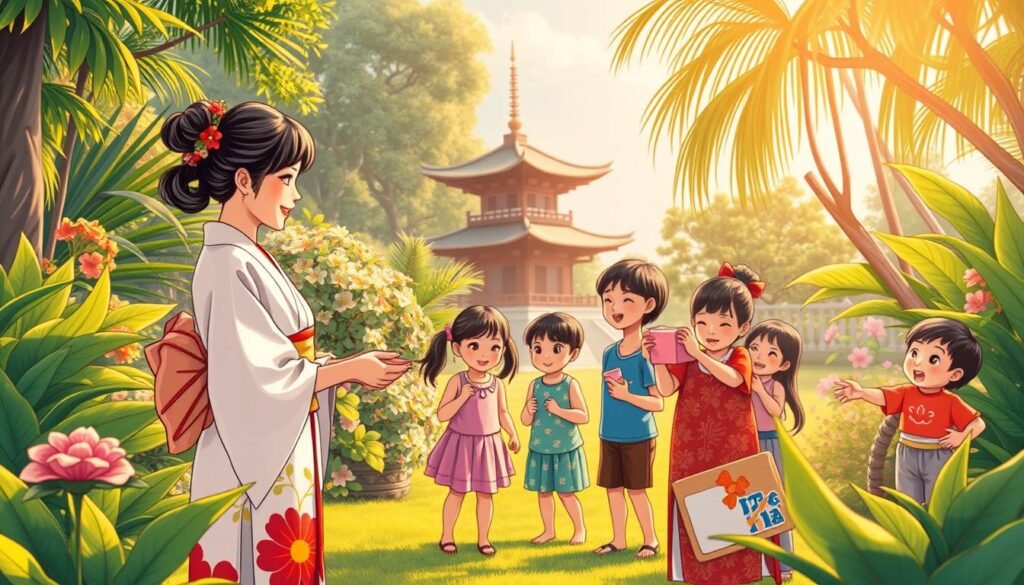
Historical ties, such as trade routes and migration patterns, laid the foundation for this cultural fusion. For example, Japanese investments in the Philippines grew significantly in the 1980s, fostering deeper connections. This economic relationship also influenced social orders, creating a unique blend of traditions.
Below is a snapshot of key economic and cultural exchanges between Japan and the Philippines:
| Year | Japanese Investments (USD Million) | Filipino Scholars in Japan |
|---|---|---|
| 1985 | 568 | 156 |
| 1986 | 485 | 89 |
| 1987 | 454 | 68 |
This table highlights the growing economic and educational ties between the two nations. Such exchanges have not only strengthened bilateral relations but also enriched cultural practices. As we delve deeper into this topic, we’ll explore how migration, trade, and evolving social orders have shaped this unique relationship.
Historical Context of Japanese Social Customs in the Philippines
The roots of Japanese social customs in the Philippines trace back to centuries of interaction. Early migration patterns and trade exchanges played a pivotal role in this cultural blend. Japanese traders and settlers began arriving in the Philippine islands as early as the 17th century, bringing with them unique traditions and practices.
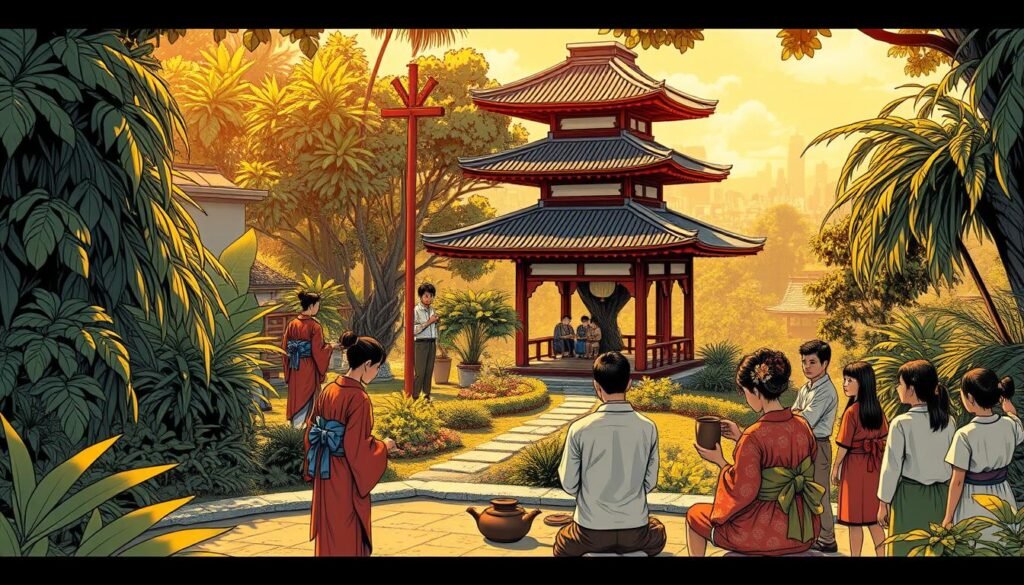
One significant aspect of this exchange was the importation of cultural practices. These ideas were gradually accepted and integrated into Filipino society. The process mirrored modern clearance protocols, where ideas were evaluated and adapted to fit local contexts.
Early Influences and Migration Patterns
Japanese migration to the Philippines began in earnest during the pre-war period. By the 1930s, over 21,000 Japanese settlers lived in Davao City alone. Many of these migrants were of mixed descent, further blending Japanese and Filipino cultures.
Historical records show that Japanese traders established communities in Manila and other key areas. These settlements became hubs for cultural exchange, fostering a mutual understanding between the two nations.
Trade and Intercultural Dialogues
Trade played a crucial role in shaping this cultural relationship. Ancient Japanese pottery discovered in Cebu in 2009 highlights early trade activity. These exchanges were not just economic but also cultural, as goods often carried symbolic meanings.
Governmental bodies, such as the bureau of trade, facilitated these interactions. They ensured that cultural practices were introduced in a structured manner, allowing for smoother integration into Filipino society.
| Year | Japanese Settlers in the Philippines | Key Locations |
|---|---|---|
| 1600s | 3,000+ | Manila, Paco |
| 1930s | 21,000+ | Davao City |
| 2009 | N/A | Cebu (Trade Evidence) |
This table illustrates the historical presence of Japanese settlers and their impact on key regions. These interactions laid the foundation for the cultural exchange we see today.
Defining Customs in Cultural and Social Contexts
Filipino societal norms have been deeply influenced by Japanese cultural practices. These traditions serve as a cultural port, facilitating the exchange of values and behaviors. Over time, this blend has shaped how Filipinos interact in both personal and professional settings.

Customs are the shared practices and behaviors that define a community. In Japan, these include bowing as a sign of respect and the emphasis on harmony. In the Philippine context, customs often revolve around family ties and community-oriented values.
Understanding Traditional Practices
Traditional practices are the foundation of cultural identity. In Japan, tea ceremonies and seasonal festivals highlight their deep-rooted traditions. Similarly, Filipino fiestas and bayanihan (community cooperation) reflect their cultural heritage.
These practices have evolved into a shared framework, blending Japanese precision with Filipino warmth. For example, the Japanese concept of omotenashi (hospitality) aligns with the Filipino value of pakikisama (harmonious relationships).
Evolution Over Time
Cultural exchange has led to the evolution of these practices. Modern influences, such as media and globalization, have accelerated this process. For instance, Japanese anime has introduced Filipino youth to Japanese values like perseverance and respect.
However, this evolution hasn’t been without challenges. The imposition of tax-like societal values, such as strict workplace etiquette, has required adaptation. Yet, Filipinos have embraced these changes, integrating them into their daily lives.
“Culture is the widening of the mind and of the spirit.” – Jawaharlal Nehru
Today, the blending of Japanese and Filipino customs continues to shape a unique cultural identity. To learn more about ancient Filipino traditions, explore this guide to Baybayin.
Role of Respect and Harmony in Both Cultures
Respect and harmony are foundational values in both Japanese and Filipino cultures. These principles shape how individuals interact, fostering mutual understanding and cooperation. While the expressions of these values differ, their essence remains deeply rooted in societal norms.
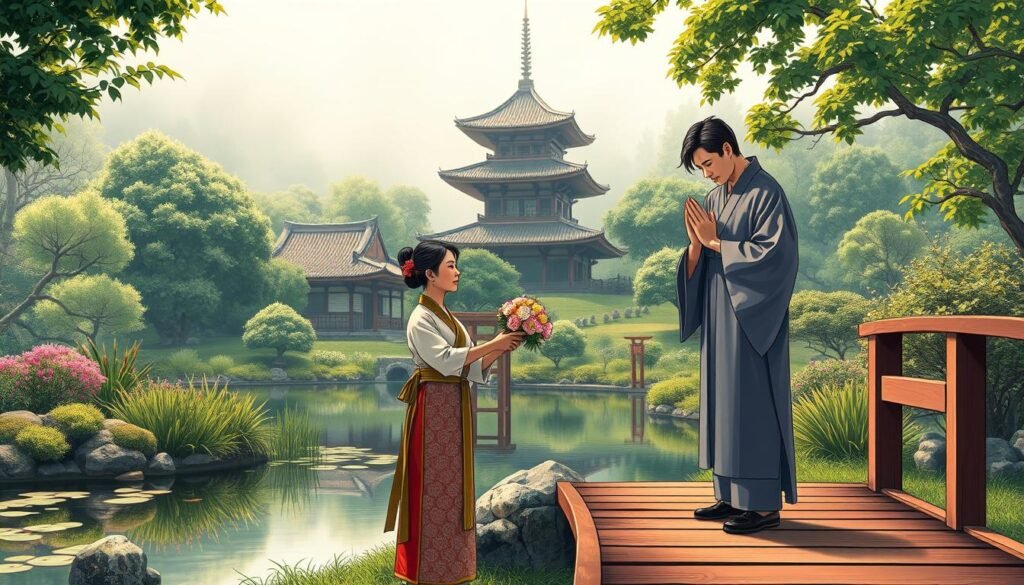
Concept of Respect in Japanese Society
In Japan, respect is a structured code that governs daily interactions. Bowing, for example, is a common gesture that signifies humility and acknowledgment of others. This practice reflects the Japanese emphasis on maintaining social order and harmony.
Japanese workplaces also adhere to strict etiquette, where hierarchical relationships are respected. Employees often address their superiors with formal titles, reinforcing the cultural code of deference. This structured approach ensures smooth functioning within organizations.
Filipino Emphasis on Community and Politeness
In the Philippines, respect is closely tied to community and family values. Politeness is expressed through gestures like “mano po,” where younger individuals show respect to elders by taking their hand and pressing it to their forehead. This practice highlights the Filipino focus on familial bonds.
Community institutions, or cultural “offices,” play a vital role in upholding these values. Barangay councils, for instance, mediate disputes and promote communal harmony. These institutions ensure that respect and politeness remain central to Filipino society.
| Aspect | Japan | Philippines |
|---|---|---|
| Expression of Respect | Bowing, formal titles | Mano po, familial gestures |
| Community Role | Workplace hierarchy | Barangay councils |
| Cultural Focus | Social order | Family and community |
Both cultures share a commitment to maintaining harmony through established codes of behavior. While Japan emphasizes formalized respect, the Philippines prioritizes collective well-being. These values continue to shape their societies, fostering mutual respect and understanding.
Filipino Etiquette and Its Unique Characteristics
Filipino etiquette is deeply rooted in a unique blend of indigenous traditions and foreign influences. This distinct value system shapes how Filipinos interact in both personal and professional settings. From hospitality to respect for elders, these practices reflect the general societal norms that define Filipino culture.
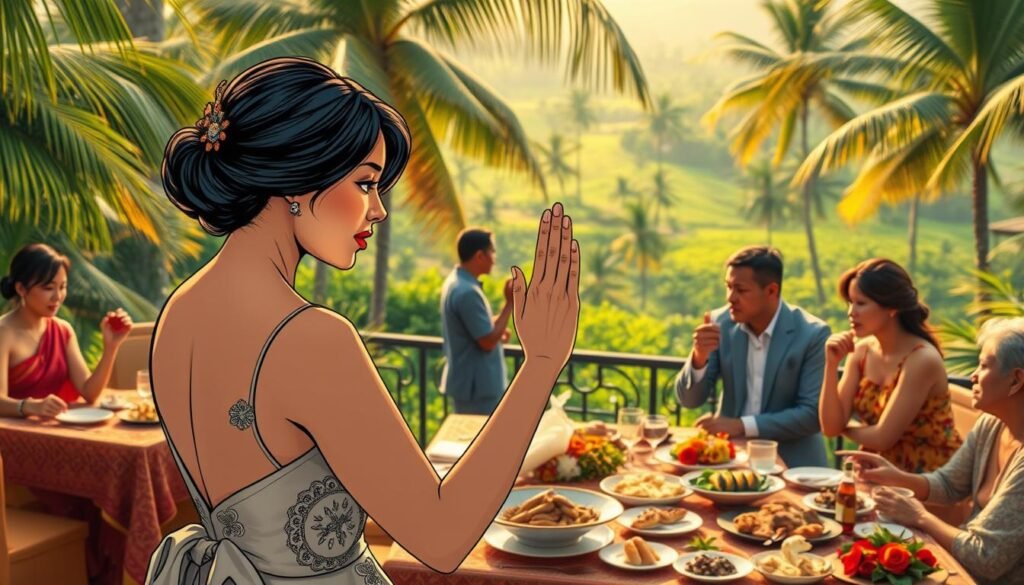
One of the most notable aspects of Filipino etiquette is its emphasis on respect. The traditional “mano po” gesture, where younger individuals take an elder’s hand and press it to their forehead, is a prime example. This practice highlights the importance of hierarchy and familial bonds in Filipino society.
Hospitality is another cornerstone of Filipino etiquette. Guests are treated with utmost care, often being offered refreshments and the finest crockery. Refusing such gestures is considered impolite, showcasing the value placed on making others feel welcome.
In social gatherings, punctuality follows a relaxed approach, often referred to as “Filipino time.” However, in formal settings like business meetings, punctuality is strictly observed. This duality reflects the adaptability of Filipino etiquette to different contexts.
Communal dining is a significant part of Filipino culture. Meals are shared, and it is polite to wait for the host to begin eating. Filipinos often leave food on the table for latecomers, emphasizing the general norm of sharing and hospitality.
Gift-giving is another essential aspect of Filipino etiquette. Thoughtfulness in presentation is highly valued, and gifts are typically not opened immediately. This practice underscores the importance of gratitude and respect in Filipino culture.
Below is a summary of key Filipino etiquette practices:
| Aspect | Practice |
|---|---|
| Respect | “Mano po” gesture, formal titles |
| Hospitality | Offering refreshments, finest crockery |
| Punctuality | Relaxed in social gatherings, strict in formal settings |
| Communal Dining | Shared meals, waiting for the host |
| Gift-Giving | Thoughtful presentation, delayed opening |
These practices highlight the form and structure of Filipino etiquette, which is deeply intertwined with community relationships and individual behavior. By understanding these unique characteristics, we gain insight into the rich cultural fabric of the Philippines.
Influence of Japanese Aesthetics on Filipino Social Interactions
The elegance of Japanese aesthetics has seamlessly woven itself into the fabric of Filipino social interactions. From the simplicity of design to the grace of daily practices, these influences are reshaping how Filipinos approach both personal and communal spaces.
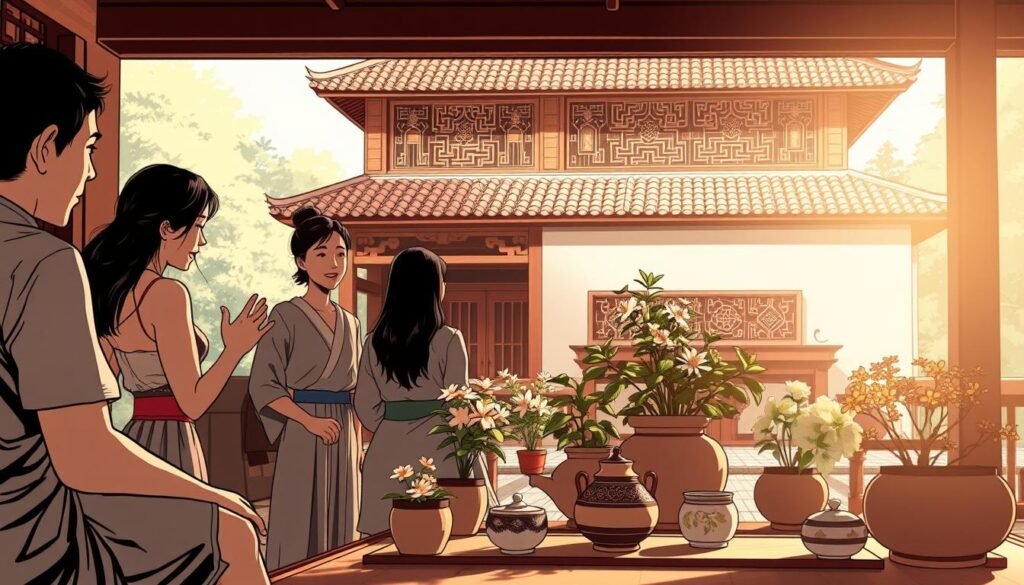
Japanese minimalism, characterized by clean lines and functional spaces, has found a home in Filipino households. This aesthetic requirement for simplicity is evident in the growing popularity of decluttered interiors and multi-purpose furniture. It reflects a shift towards mindful living, inspired by Japanese principles.
Minimalism and Grace in Daily Practices
In daily life, the influence of Japanese aesthetics is unmistakable. Practices like mindful eating, where meals are prepared and consumed with care, mirror the Japanese concept of ichiju-sansai (one soup, three dishes). This approach emphasizes balance and appreciation for food, a value increasingly adopted by Filipinos.
Another example is the official adoption of Japanese-inspired public spaces. Parks and community centers now feature Zen gardens and minimalist designs, promoting tranquility and social harmony. These spaces serve as a testament to the blending of Japanese and Filipino values.
Modern Adaptations of Traditional Values
Modern Filipino society is embracing traditional Japanese values in innovative ways. The government has launched programs to promote cultural exchange, such as art exhibitions and workshops. These initiatives encourage Filipinos to explore Japanese aesthetics while preserving their own heritage.
Cultural influencers are also playing a key role. They advocate for the integration of Japanese minimalism into Filipino lifestyles, meeting the requirement for both functionality and beauty. This balance ensures that traditional values remain relevant in a rapidly changing world.
“Simplicity is the ultimate sophistication.” – Leonardo da Vinci
By blending Japanese aesthetics with Filipino traditions, a unique cultural identity is emerging. This fusion not only enhances social interactions but also fosters a deeper appreciation for the beauty of simplicity and grace.
Traditional Filipino Practices Shaped by Foreign Customs
Traditional Filipino practices have evolved significantly through the integration of foreign influences, particularly from Japan. This blending of traditions has created a unique cultural identity, reflecting both local heritage and global connections. Cultural officers play a vital role in documenting and preserving these practices, ensuring they remain relevant in modern society.
One notable example is the adaptation of Japanese tea ceremonies into Filipino hospitality practices. The emphasis on mindfulness and respect in these ceremonies aligns with Filipino values of warmth and generosity. Regulatory standards have been established to guide this cultural integration, ensuring that foreign influences enhance rather than overshadow local traditions.
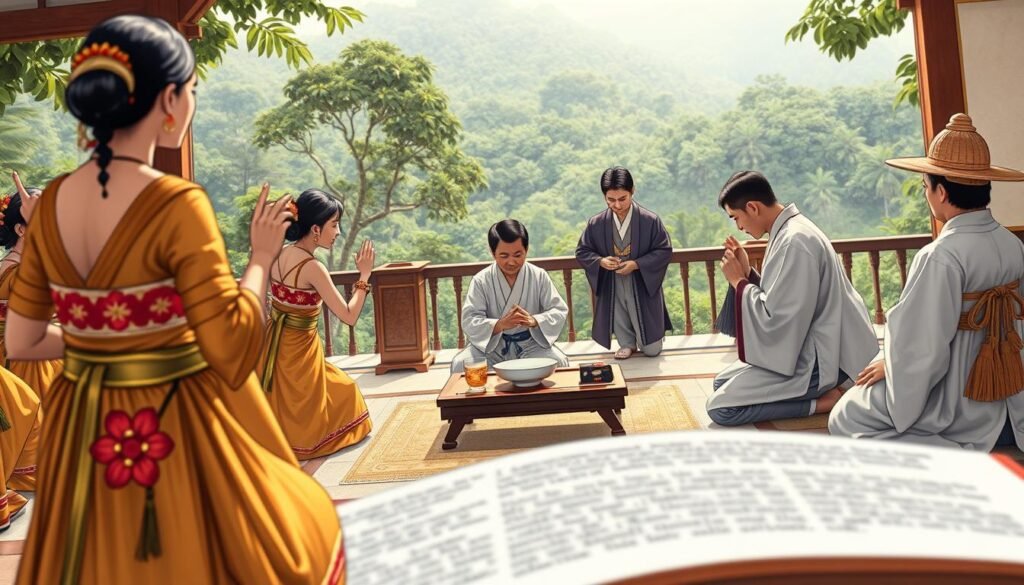
Foreign agencies and international cultural bodies have also contributed to this exchange. Programs promoting cultural awareness, such as art exhibitions and workshops, encourage Filipinos to explore Japanese traditions while celebrating their own heritage. These initiatives are often led by cultural officers, who act as bridges between communities.
Specific events, like the Ati-Atihan Festival, now incorporate elements of Japanese aesthetics and practices. This blending of customs highlights the adaptability of Filipino culture and its openness to global influences. Over time, these methods have been standardized through both formal and informal channels, ensuring consistency and authenticity.
“Culture is the intersection of people and life itself.” – Wes Anderson
The role of cultural officers and regulatory standards cannot be overstated. They ensure that foreign practices are integrated thoughtfully, preserving the essence of Filipino traditions. This collaborative effort between local and foreign agencies has enriched the cultural landscape of the Philippines, creating a vibrant and dynamic society.
Impact of Modernization on Filipino Social Customs
Modernization has become a powerful resource reshaping Filipino social interactions. From technology to organizational reforms, these changes are transforming how Filipinos connect and communicate. This evolution brings both challenges and opportunities, blending traditional values with modern practices.
One significant area of change is the relief provided by modern technology. Social media platforms and messaging apps have revolutionized daily communication, especially for families with overseas members. These tools bridge distances, allowing Filipinos to maintain strong family ties despite physical separation.

Daily practices have also evolved in the digital age. For example, younger generations often act as digital mentors, teaching older family members how to navigate online platforms. This shift highlights the adaptability of Filipino society while preserving its core values of respect and unity.
Modern ideologies are being integrated with traditional norms in innovative ways. While 80% of Filipino families still uphold traditional values like respect for elders, they are also embracing modern lifestyles. This balance ensures that cultural heritage remains relevant in a rapidly changing world.
“Change is the law of life. And those who look only to the past or present are certain to miss the future.” – John F. Kennedy
Real-life examples of this integration are evident in Filipino workplaces. Remote work trends have introduced new dynamics, encouraging work-life integration. This shift reflects the adaptability of Filipino professionals, who are redefining traditional roles to meet modern demands.
In summary, modernization serves as a vital resource for Filipino society. It provides relief through technological advancements and fosters innovation in daily practices. By balancing modern influences with traditional values, Filipinos are creating a dynamic and resilient cultural identity.
Governmental Perspectives on Cultural Regulations
The Philippine government plays a pivotal role in shaping cultural regulations and preserving heritage. Through various agencies and policies, it ensures that cultural practices are protected while adapting to modern influences. This balance is crucial in maintaining the nation’s identity in a globalized world.
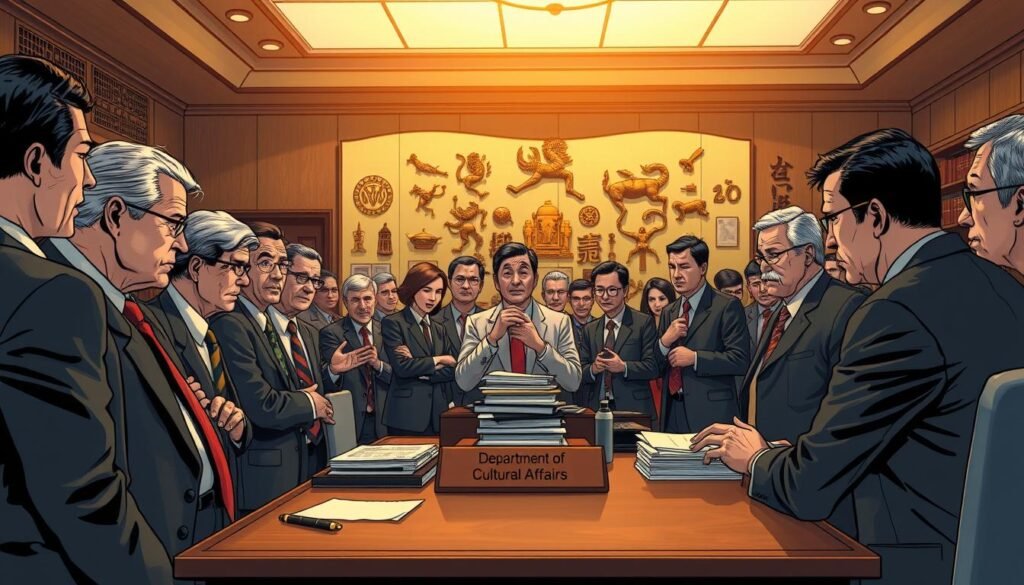
Insights from Official Philippine Sources
Official sources like GOV.PH and the Official Gazette provide valuable insights into cultural regulations. These platforms highlight the importance of intellectual property in safeguarding cultural heritage. For instance, the modernization tariff act has been instrumental in regulating imported cultural goods, ensuring they align with local values.
State policies also emphasize the role of citizens in preserving cultural traditions. Programs promoting awareness and participation in cultural activities are widely supported. This approach fosters a sense of ownership and responsibility among Filipinos.
Here are key governmental initiatives in cultural regulation:
- Implementation of the modernization tariff act to control cultural imports.
- Promotion of intellectual property rights to protect traditional knowledge.
- Encouraging citizens to actively participate in cultural preservation efforts.
Cultural policy initiatives, such as those discussed in this study, demonstrate how trust in government shapes public attitudes towards cultural regulations. This connection is vital in ensuring the success of these policies.
In conclusion, the Philippine government’s approach to cultural regulation is comprehensive and forward-thinking. By integrating modern policies with traditional values, it ensures the preservation of cultural heritage for future generations.
The Role of Media in Promoting Cultural Interactions
Media has become a powerful tool in bridging cultural gaps between Japan and the Philippines. Through various platforms, it showcases the blend of traditions, fostering mutual understanding and appreciation. This duty of media houses is crucial in educating the public about evolving etiquettes and cultural heritage.
Official channels, including bureau customs, play a significant role in reporting on cultural developments. They ensure that the public stays informed about the integration of Japanese practices into Filipino life. This transparency helps maintain the authenticity of cultural exchanges.
Media products like documentaries, articles, and online content have been instrumental in highlighting these interactions. For instance, documentaries on Japanese tea ceremonies or Filipino fiestas provide insights into shared values. These products not only educate but also inspire audiences to embrace cultural diversity.
Social media platforms have further amplified this cultural exchange. They allow for real-time sharing of traditions, making it easier for younger generations to connect with their heritage. This modern approach ensures that cultural practices remain relevant in a rapidly changing world.
“Media is the bridge that connects cultures, fostering understanding and unity.”
To learn more about how media shapes cultural dynamics, explore this study on media and cultural integration.
In conclusion, the media’s duty in promoting cultural interactions cannot be overstated. By showcasing the blend of Japanese and Filipino customs, it bridges traditional values with modern societal norms, creating a harmonious cultural landscape.
Integrating Japanese Values in Philippine Daily Etiquette
The blending of Japanese values into Filipino daily life has created a unique cultural synergy. This integration has enriched Filipino etiquette, fostering respect, harmony, and mindfulness in social interactions. The process of adopting these values has been gradual, yet impactful, shaping how Filipinos navigate personal and professional spaces.
One significant benefit of this cultural import is the emphasis on respect and discipline. Practices like bowing and punctuality, rooted in Japanese traditions, have become valuable social property in the Philippines. These practices not only enhance interpersonal relationships but also contribute to a more structured and harmonious society.
The intellectual exchange between Japan and the Philippines has also played a crucial role. Educational programs and cultural workshops have introduced Filipinos to Japanese philosophies like wa (harmony) and omotenashi (hospitality). These concepts have been seamlessly integrated into Filipino values, creating a shared framework for social interactions.
Practical examples of this integration are evident in various settings. In workplaces, the Japanese practice of kaizen (continuous improvement) has inspired Filipino professionals to adopt a growth mindset. In schools, the emphasis on group activities and teamwork reflects the Japanese value of collective effort. Community gatherings, too, showcase this blend, with Filipino fiestas incorporating elements of Japanese aesthetics and mindfulness.
Here’s a comparison of key Japanese and Filipino values:
| Aspect | Japanese Values | Filipino Values |
|---|---|---|
| Respect | Bowing, formal titles | Mano po, familial gestures |
| Harmony | Wa (group harmony) | Pakikisama (social harmony) |
| Hospitality | Omotenashi (selfless service) | Bayanihan (community cooperation) |
The long-term impact of this cultural enrichment is profound. It has strengthened national identity, fostering a sense of pride in the shared heritage of Japan and the Philippines. Social cohesion has also improved, as Filipinos embrace values that promote unity and mutual respect.
“Culture is the widening of the mind and of the spirit.” – Jawaharlal Nehru
By integrating Japanese values into daily etiquette, Filipinos have created a dynamic and resilient cultural identity. To explore more about the historical influences on Filipino culture, check out this article on colonial influences.
How Cultural Importation Shapes National Identity
Cultural importation has become a cornerstone in shaping the national identity of the Philippines. By integrating foreign practices, Filipinos have created a unique blend of traditions that reflect both local heritage and global influences. This process is guided by specific rules and frameworks, ensuring that cultural exchange enriches rather than overshadows local values.
Economic and Social Impacts
The economic benefits of cultural importation are significant. Foreign investments, particularly from Japan, have introduced new industries and job opportunities. These economic ties have also fostered social connections, creating a mutual understanding between the two nations.
Socially, the integration of foreign customs has reshaped daily interactions. Practices like punctuality and respect for hierarchy, rooted in Japanese traditions, have become valuable social property in the Philippines. These changes highlight the adaptability of Filipino society.
Cultural Hybridity and Resilience
Cultural hybridity is a testament to the resilience of Filipino identity. The blending of Japanese and Filipino traditions has created a dynamic cultural landscape. For example, the Japanese concept of wa (harmony) aligns with the Filipino value of pakikisama (social harmony).
New cultural entries, such as Japanese aesthetics in Filipino design, continuously enrich the national identity. This adaptability ensures that Filipino culture remains vibrant and relevant in a rapidly changing world.
“Culture is the widening of the mind and of the spirit.” – Jawaharlal Nehru
Below is a summary of key impacts of cultural importation:
| Aspect | Impact |
|---|---|
| Economic | Job creation, foreign investments |
| Social | Enhanced respect, structured interactions |
| Cultural | Hybrid traditions, enriched identity |
In conclusion, cultural importation plays a vital role in shaping the national identity of the Philippines. By embracing foreign practices while preserving local values, Filipinos have created a resilient and dynamic cultural identity.
Customs: Merging Tradition with Regulatory Practices
The integration of traditional practices with modern regulatory frameworks is reshaping Filipino social norms. This blend of old and new ensures that cultural heritage remains relevant while adapting to contemporary needs. Government departments play a crucial role in guiding this process, ensuring that traditions align with structured regulations.
Overview of Bureau Guidelines and Protocols
Government departments have established specific guidelines to merge tradition with modern practices. These protocols ensure that cultural values are preserved while meeting the demands of a globalized society. For example, the Revised Kyoto Convention, introduced in 2006, serves as a key instrument for trade facilitation, balancing tradition with modern regulations.
The SAFE Framework of Standards, introduced in 2005, focuses on securing and facilitating global trade. This framework highlights the importance of risk management in customs operations, ensuring that traditional practices are integrated into modern systems. These acts and guidelines provide a structured approach to cultural preservation.
Comparing Social Norms with Formal Customs
Informal social norms often differ from formal customs as regulated by official acts. For instance, the traditional Filipino value of pakikisama (social harmony) aligns with the Japanese concept of wa (group harmony). However, formal regulations require a more structured approach, such as compliance with trade facilitation agreements.
Here’s a comparison of social norms and formal customs:
| Aspect | Social Norms | Formal Customs |
|---|---|---|
| Respect | Mano po, familial gestures | Bowing, formal titles |
| Harmony | Pakikisama (social harmony) | Wa (group harmony) |
| Compliance | Community-oriented | Structured regulations |
These comparisons highlight the adaptability of Filipino society in merging tradition with modern regulations.
Specific examples of compliance with bureau guidelines illustrate this merger. For instance, the implementation of the Trade Facilitation Agreement in 2013 has enhanced trade while preserving cultural values. This balance ensures that traditional practices remain relevant in a rapidly changing world.
“The blending of tradition and regulation ensures cultural resilience in a globalized society.”
To learn more about the role of departments in cultural preservation, explore this detailed guide on regulatory practices.
In conclusion, the merger of tradition with regulatory practices is essential for cultural preservation. By aligning traditional values with modern regulations, Filipinos ensure that their heritage remains vibrant and relevant.
Contemporary Challenges in Balancing Tradition and Global Influence
Balancing tradition with global influences presents unique challenges for Filipino society. As globalization accelerates, the integration of foreign practices often clashes with deeply rooted cultural norms. Policymakers face the complex task of preserving cultural integrity while embracing international trends.
One major challenge is the economic impact of globalization. Updated tariff policies are essential to regulate the influx of foreign goods and ideas. These measures help protect local industries while allowing for beneficial cultural exchange. For example, the supplement of traditional crafts with modern designs has revitalized local markets.
Socially, the integration of global practices requires careful navigation. A summary of key issues reveals that younger generations often adopt foreign customs more readily than older ones. This generational divide can strain familial and community relationships, highlighting the need for balanced cultural policies.
Real-world examples illustrate these challenges. In urban areas, the rise of multinational corporations has introduced new workplace norms. While these changes boost economic growth, they often conflict with traditional Filipino values like family-first priorities. Supplemental measures, such as cultural awareness programs, help bridge this gap.
In conclusion, careful regulation is crucial for balancing tradition and globalization. By implementing updated tariffs and fostering cultural dialogue, policymakers can ensure that Filipino heritage remains vibrant. As explored in this article on balancing tradition and relevance, the key lies in adapting without losing core values.
Future Outlook on Filipino Etiquette and Cultural Customs
The future of Filipino etiquette and cultural practices is being reshaped by technological advancements and global influences. As the world becomes more interconnected, the Philippines is adapting to new norms while preserving its rich heritage. This balance between tradition and modernity is crucial for maintaining cultural identity in a rapidly changing world.
Technological Integration in Cultural Practices
Emerging technologies are playing a significant role in the evolution of Filipino customs. Social media platforms and digital tools are transforming how Filipinos communicate and celebrate traditions. For example, virtual fiestas and online cultural workshops have become popular, allowing people to connect and share their heritage globally.
Government circulars are also guiding this integration. These directives ensure that technological advancements enhance cultural practices without overshadowing traditional values. By embracing innovation, Filipinos are finding new ways to preserve and promote their customs.
Evolving Social Norms in a Globalized World
Globalization is influencing Filipino social norms, creating a dynamic cultural landscape. Practices like punctuality and workplace etiquette are evolving, reflecting international standards. The tariff act has also facilitated trade, bringing new ideas and practices to the Philippines.
However, this evolution comes with challenges. Balancing global influences with local traditions requires careful navigation. Cultural sections within government agencies are working to ensure that these changes align with Filipino values, fostering a harmonious blend of old and new.
Looking ahead, the Philippines has the opportunity to lead in cultural innovation. By integrating technology and global trends, Filipinos can create a vibrant and resilient cultural identity. This approach ensures that traditions remain relevant while embracing the benefits of a connected world.
“The future belongs to those who prepare for it today.” – Malcolm X
To learn more about the evolving cultural landscape, explore this detailed guide on Filipino cultural practices.
Conclusion
The interplay between Japanese social customs and Filipino etiquette highlights a dynamic cultural evolution. Over time, these influences have reshaped how Filipinos interact, blending respect, harmony, and mindfulness into daily life.
Balancing historical heritage with modern frameworks, such as the modernization tariff, ensures cultural preservation while adapting to global trends. Government initiatives play a crucial role in facilitating this integration, fostering a resilient national identity.
As both traditions and innovations continue to shape societal behavior, the role of service in cultural exchange becomes increasingly vital. This ongoing process enriches Filipino identity, creating a unique blend of local and global values.
Understanding these cross-cultural dynamics offers deeper insights into how traditions evolve. By embracing both heritage and modernity, Filipinos continue to build a vibrant and adaptable society.
FAQ
How have Japanese social customs influenced Filipino etiquette?
Japanese social customs have shaped Filipino etiquette by introducing values like respect, harmony, and minimalism. These elements are now integrated into daily Filipino practices, such as politeness and community-oriented behavior.
What is the historical context of Japanese influence in the Philippines?
Japanese influence in the Philippines dates back to early migration and trade. Over time, intercultural dialogues have fostered a blend of traditions, impacting Filipino social norms and practices.
How do Filipino and Japanese concepts of respect differ?
In Japanese society, respect is deeply tied to hierarchy and harmony. In the Philippines, respect emphasizes community and politeness, often expressed through gestures like “po” and “opo.”
What role does media play in promoting cultural interactions between Japan and the Philippines?
Media serves as a bridge, showcasing Japanese aesthetics and values through TV shows, films, and social platforms. This exposure encourages Filipinos to adopt and adapt these practices into their daily lives.
How has modernization affected Filipino social customs?
Modernization has introduced global influences, blending traditional Filipino practices with foreign customs. This has led to a dynamic cultural landscape that balances heritage with contemporary trends.
What are the challenges in balancing tradition and global influence in the Philippines?
Challenges include preserving cultural identity while embracing globalization. Filipinos strive to maintain traditional values while adapting to modern, foreign-inspired practices.
How does cultural importation shape national identity in the Philippines?
Cultural importation fosters hybridity, blending Filipino traditions with foreign influences. This creates a resilient national identity that reflects both local heritage and global connections.
What is the future outlook for Filipino etiquette and cultural customs?
The future involves integrating technology into cultural practices and evolving social norms. Filipinos will continue to adapt, ensuring their etiquette remains relevant in a globalized world.
Source Links
- Cultural Crossroads: Challenges Filipinos Face Living in Japan and How to Overcome Them
- Navigating Japanese Social Customs: A 2025 Guide to Cultural Etiquette
- Economic and Cultural Determinants of Mutual Images in an Unequal Cooperative Dyad
- Colonial Legacies: Spanish, American, and Japanese Influences on Filipino Culture and the Modern Employee
- Japanese in the Philippines
- How Customs Affect Society
- Culture | Definition, Characteristics, Examples, Types, Tradition, & Facts | Britannica
- Chapter 3. Culture
- Understanding Collectivist Cultures
- 21.3 The Role of Culture in Shaping Health Beliefs and Practices – Population Health for Nurses | OpenStax
- Social Cohesion: Fostering Unity and Harmony in Communities
- Filipino – Etiquette
- Filipino Customs and Etiquette
- The Influence of Contemporary Japanese Arts in the Philippines
- The Impact of Japanese Pop Culture on Filipino Youth
- Culture of the Philippines
- Philippine Culture: Learning About Traditions and Customs | Asterra
- Philippines – Culture, Diversity, Traditions | Britannica
- Lecture Notes 5
- Culture Clash: Traditional Values and Modern Challenges in Filipino Families
- Cultural policy
- United Nations For Indigenous Peoples
- How Does Media Influence Social Norms? A Field Experiment on the Role of Common Knowledge.
- The Impact of Global Communication: Transforming Interactions in a Connected World
- Communication competencies, culture and SDGs: effective processes to cross-cultural communication – Humanities and Social Sciences Communications
- Do You See What I See? ‘Religion’ and Acculturation in Filipino–Japanese International Families
- Japanese etiquette and social norms
- China’s Traditional Cultural Values and National Identity
- Frontiers | Research hotspots and frontiers of ethnic cultural identity——based on analysis of “web of science” database
- Conceptions of National Identity and Ambivalence towards Immigration | British Journal of Political Science | Cambridge Core
- 構成案(やり直し)
- Globalization Benefits and Challenges
- Multiculturalism | Definition, Impact, Challenges, & Facts | Britannica
- Philippine Culture and Etiquette: What To Know – Culture With Travel
- Filipino Heritage: How to Dive Deep into Your Culture
- No title found
- Conclusion – Custom as a Source of Law

